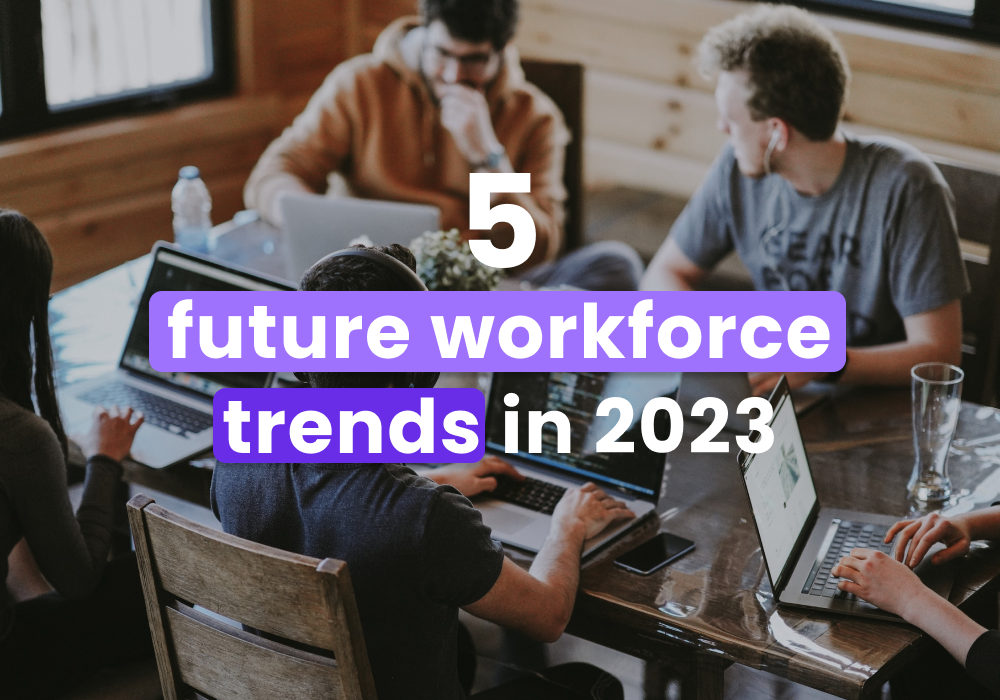As the world of work continues evolving, so too do the trends that dictate its shape. Ergo, as this year unfolds (2023), we expect the workforce to look slightly different than it does today.
In 2022, we saw technological advances, artificial intelligence, and increasing automation transform how we work. As a result, more and more jobs can be computerized, and those that remain are becoming increasingly specialized, requiring workers to have higher levels of education and training. This shift will likely lead to less demand for talent to fill low-skilled jobs and an increased need for highly skilled professionals.
Furthermore, as we'll discuss, remote work will probably become even more popular as technology continues to make it easier to operate productively from anywhere in the world. Needless to say, this will also make it easier for companies to hire talent worldwide and potentially reduce overhead costs. While simultaneously allowing workers more flexibility in their work schedules- which, incidentally, is something more and more of us are craving. In fact, a survey indicates that 65% of American workers report wanting full-time remote work.
Finally, the gig economy will likely grow significantly over the next few years. Companies increasingly turn to freelancers and contract workers to execute specialized projects and tasks. Interestingly, as many as 16% of Americans say they’ve used an online gig platform to earn money - and there are plenty of good reasons. For example, freelancing gives workers more flexibility and the potential to make more money. Upwork reports that seven out of ten workers say it took less than a year to earn more as a freelancer than they did with their past employer. Clearly, there are notable benefits to be gained from both parties, so it’s easy to see why the gig economy is expected to flourish.
So, with all that in mind, here we’ll explore five prominent trends likely to define the workforce in 2023. From the surge in remote working to the continued growth of artificial intelligence, these five trends could shape how we work and live for years to come. Let’s take a look…
1. The Continued Growth of Remote and Flexible Work
In a nutshell, the gig economy is a labor market denoted by the prevalence of short-term contracts and freelance work, as opposed to permanent jobs. Gig workers are generally self-employed and aren’t entitled to traditional employment benefits. However, instead, they enjoy increased flexibility and opportunities that come with self-employment.
This way of working is increasingly viable thanks to better access to stable internet connections, social media, and the dawning of collaboration tools like Google Docs, Zoom, Slack, etc. All of this combined better positions people to find, negotiate and complete jobs quickly and easily.
With the advent of covid, the gig economy expanded exponentially. In fact, the freelance market is predicted to reach a whopping $455 billion in 2023. Interestingly, Upwork reports that the American freelance workforce reached a high of 60 million in 2022, accounting for as much as 39% of the total workforce. Elsewhere, in the EU, the number of self-employed workers sits at 26.9 million, comprising roughly 14% of Europe’s workforce.
There may be several reasons for this:
-
86% of workers are happier working at home.
-
68% say they have fewer interruptions and can be more productive.
-
While another 79% said, they enjoy a better work-life balance by cutting out their commute.
-
Remote also working lends itself to more convenience and flexibility. In fact, 21% of those actively seeking new work want more flexible working arrangements.
Lastly, now that many of us have experienced remote work during the pandemic, we are more confident we can work from home. In fact, 54% (equivalent to 92 million) of people in the US say they work from home full-time or part-time already. Similarly, 78% of workers in the EU said they would like to occasionally work from home.
With these incentives, it’s no surprise that employees continue pushing for the option to work from home/remotely.
Of course, the gig economy is by no means a new phenomenon. However, as the freelance market continues to swell, employers have a choice to make - whether to utilize freelancers or not.
Consider that “when people have the chance to work flexibly, 87 percent of them take it” (McKinsey). However, global talent shortages are making this process difficult, with three out of four employers struggling to find the talent they need.
Incorporating freelancers into your team could be the answer. However, that isn’t to say that there aren’t challenges to integrating freelance workers into your team, such as maintaining company culture, communication barriers, and lack of supervision. Often, concerns like these prevent employers from utilizing the gig economy to the fullest.
This is where a freelance management system could present a solution. For example, Bubty provides a centralized approach that allows you to easily match workers to the right roles. It also facilitates communication with its built-in messaging tools and makes sharing essential files like your employee handbook a breeze. Thus, enabling you to provide recruits with an insight into your company culture from the get-go.
There are still many employees that value the stability of a full-time position. Couple this with the fact that working remotely is increasingly viable; you could use a freelance management system to allow staff the flexibility to self-determine their schedules.
2. AI
AI is quickly becoming an essential technology for workplaces all around the globe. From automated email campaigns to sending notifications, AI makes it easier to pay invoices, collect data, move candidates through various funnels, and much more.
In the last four years, the commercial use of AI has increased by 270%. To some, the sweeping wave of automation is daunting. After all, by 2030, one-third of all jobs could be at risk of being automated. The most affected will be workers with low skill and/or education levels. As a result, the labor market will increasingly focus on highly skilled, specialized talent.
It’s all too easy to view AI as a threat to the workforce. However, it's just as likely that AI will continue to drive innovation, resulting in new jobs. However, AI still lacks the human intelligence to perform specific tasks, so sectors requiring human interaction will likely remain largely unaffected.
The bottom line for recruiters: Instead of looking to replace staff, consider training and upskilling workers to ensure you're making the most out of AI.
3. Bridging Skills Gaps
For the uninitiated, a ‘skills gap’ represents the gap in the number of people qualified to fill the positions available in the labor market. This gap is often the result of a lack of training, outdated knowledge, or inadequate resources.
Korn Ferry reports that by 2030, more than 80 million jobs (an untapped revenue of nearly $8.5 trillion) could go unfilled because there aren’t enough skilled individuals to fill them. Particularly in the US, we see a growing gap between the number of job openings and those suited to serve them. McKinsey also reports that in 2023, Europe will suffer from a similar deficit totaling 8.6 million workers.
To combat this issue, 78% of hiring managers agree they need to reassess how they hire, but where should we start?
-
Letting go of credential-based hiring. Unfortunately, a degree doesn’t always equal competency. Until what’s taught in classrooms aligns with the skillsets required of particular jobs, experience and ability should take precedence. For example, you could assess a candidate’s ability by asking them to complete a job-related exercise that tests the skills needed for the role. For example, this could include a writing, maths, or coding challenge.
-
Upskilling current employees. Acquiring the right skillset doesn’t always mean looking outwards. By implementing in-house upskilling programs, you can mold current employees into the workers you require.
-
Welcoming a broader roster of candidates. One key benefit of remote work is that it’s not geographically bound. As such, employers can source hires from a much larger talent pool, increasing the likelihood of finding applicants with the skills your business needs. Plus, it’s an opportunity to create a more diverse workforce - a win-win!
4. Prioritizing Employee Mental Health
Many workplace studies emphasize the importance of acknowledging and prioritizing employee health and mental well-being. For instance, an inquiry commissioned by the AU government showed that reforming the mental health system, focusing on improving workers' lives, could save $18 billion annually for the Australian economy.
They cited that increased mental health support could improve economic participation, reduce mental health-related expenditures (sick days and sick pay, etc.), and generate savings upwards of $1.2 billion.
When employees experience positive mental health and well-being, they’re better able to cope with stress, stay focused and motivated, and make better decisions. One case study shows that job satisfaction, burnout, and staff turnover are intrinsically linked.
The moral of the story? It’s wise to prioritize your employee’s mental health.
Here are a few pointers to help you hit the ground running with this:
-
If you don’t already, start nurturing a supportive workplace environment.
-
Encourage employees to enforce work-life boundaries.
-
Ensure your workplace is free of bullying, harassment, and discrimination. For example, ensure you have policies to tackle these issues and enforce them where necessary.
5. Leveraging Tech as a Powerful Tool
Hands up if you’ve ever viewed technology as an obstacle. Don’t worry; we’ve all been there. Unfortunately, implementing new software can sometimes seem more trouble than it’s worth.
However, instead of adopting this attitude, why not see 2023 as the year you’ll embrace technology to facilitate a more productive workplace?
The right software can empower you to streamline administrative tasks, enhance communication and collaboration, and automate repetitive jobs, enabling you and your employees to focus on higher-value tasks.
AI, for instance, could reportedly add more than $2.9 trillion to global business value by helping companies make more profitable decisions and supporting their workers. In fact, by automating routine tasks using AI, companies around the world could save a collective 6.2 billion hours of work.
For example, cloud-based freelance management systems can help teams organize tasks, monitor progress, and collaborate in real-time, increasing efficiency across your organization.
Working With Bubty to Put Your Best Foot Forward in 2023
With the rise in remote working, the gig economy, and technological development, businesses need an efficient and cost-effective way to manage their workforce.
Bubty provides businesses with a systemized way to manage their freelance talent pools. For example, one barrier organizations frequently face when collating a geographically diverse team is compliance with local labor laws and regulations. However, Bubty enables you to provide freelancers with automated self-service onboarding features. This makes it simple to keep tabs on documents, invoices, payments, and compliance matters from one cloud-based system.
Additionally, the system provides businesses with tools to better allocate resources. For example, you can see when workers are available and track project times, to name but a few of Bubty’s extensive list of features.
By leveraging the power of Bubty, businesses can better tackle 2023’s workforce trends and confidently manage their freelancers. To find out more, book a call with us today.




